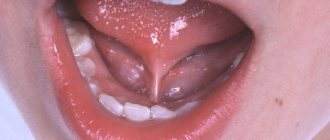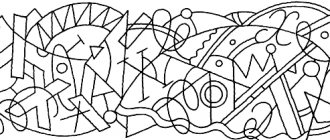About the disease
Stuttering is a violation of the smoothness and rhythm of speech, in which the child has difficulty pronouncing words and phrases, repeated repetition of syllables or short words, and lengthening of pauses before the start of pronunciation.
The disorder is based on spastic contraction of structures that provide speech function (muscles of the larynx, tongue, soft palate, lips). Spasms are caused by excessive stimulation of the corresponding centers in the brain (speech, emotional). As a result, articulatory, vocal or respiratory contractions occur that prevent the child from speaking smoothly and rhythmically. Most often, stuttering occurs in children 2-4 and 5-7 years old. This disorder is found 4 times more often in boys than in girls. In 50-80% of cases the condition can be corrected. The key to success is timely seeking qualified help. The earlier therapy is started, the greater the chances of getting rid of the speech defect forever.
Eliminating stuttering in children
Treatment of stuttering in children is carried out by a speech therapist. If pathologies have caused cramps in the muscles of the articulatory apparatus or diseases of the nervous system, you may need the help of a neurologist. If stuttering occurs after a traumatic situation, you may need to work with a psychologist.
The essence of treatment for this pathology is to restore the functions of the speech circle, including inhibition of Broca's center. In the correction of stuttering, drug therapy, hypnosis, acupuncture, various relaxing procedures, and special exercises are used. In some cases, it may be necessary to use anti-stuttering devices and special computer programs.
Drug treatment for stuttering includes taking anticonvulsants, anti-anxiety, sedatives and various homeopathic medications. In some cases, neurometabolic stimulants may be used. However, this method of treatment can only be used for children over 3 years of age.
Thanks to hypnosis, the doctor will be able to identify the true causes of the disorder. Improvement in condition can be achieved even after 1 procedure. For residual elimination of pathology, 10-15 sessions may be required. In this way, stuttering in adolescents is eliminated. The method is not used to treat young children.
Stuttering can be treated with acupressure. Thanks to it, speech regulation is significantly improved. During the massage, the doctor uses a relaxing method of influence. During the session, the specialist presses on special points and performs circular movements.
Breathing exercises have shown good results in the treatment of stuttering. The essence of the method is to normalize breathing and lengthen inhalation. Thanks to this, the child can learn to stock up on air before saying anything. This method of treatment is used for children over 4 years of age.
In addition, logorhythmics can be used to correct pathology. The essence of this method is to use the connection of a word with melody and movements. Thanks to logorhythmics, a child will be able to correct speech defects, reveal their talents and improve self-esteem. The method is used to treat children under 7 years of age and older.
To eliminate stuttering, your doctor may recommend the use of anti-stuttering devices. Some devices help the child hear the spoken line with a slight blurring, others drown out the voice with noise, and others reproduce a corrected version of speech. The most effective devices are those that lower or raise the volume of the voice.
Types of logoneuroses
Depending on the reasons, there are 2 forms of stuttering.
The neurosis-like form implies speech disorders against the background of systemic neurosis. This type of disorder is difficult to treat because it is genetically determined. Children with this form have slightly different brain functioning than normal children. Such children begin to speak later and develop more slowly than their peers. The neurotic form of stuttering develops against the background of severe shocks or chronic stress. As a rule, a child begins to stutter after being frightened. In the future, spasms of the speech muscles are repeated more and more often, and a fear of speaking develops. This form responds well to treatment if it is not started in time. Depending on the nature of speech disorders, the following types of stuttering are distinguished:
- tonic – the child stretches out certain sounds or makes inappropriate pauses;
- clonic - the baby repeats words or sounds;
- mixed - pauses and repetitions are present simultaneously.
According to the literature [1-3], the average prevalence of tics in children is 4-16%. They are determined by a group of causal factors, the role of which is individual in each specific case. Polymorphism also concerns the mechanisms of pathogenesis and clinical manifestation of the disease.
The social significance of tics is determined not only by hyperkinesis, but also by comorbid cognitive and behavioral disorders. The latter include attention deficit hyperactivity disorder, anxiety and obsessive-compulsive disorders [4], as well as stuttering [5].
Stuttering is a speech disorder in which the fluency of speech is impaired. When stuttering, involuntary delays in the pronunciation of individual sounds or syllables (tonic stuttering) or involuntary repetition of them (clonic stuttering) occur. In addition, a combined tonic-clonic form occurs. Stuttering, like tics, is a fairly common disease in childhood. Yu.V. Popov and V.D. View [6] provides the following data regarding the frequency of this pathology: 2-4% in children, 1% in adolescents. According to H. Remschmidt [7] and K.Yu. Retyunsky [8], stuttering occurs in 2% of girls and 5% of boys. E. Yairi and N. Ambrose [9] provide data on stuttering in 5% of children.
In the development of stuttering, a large role is played by heredity, perinatal pathology, as well as the influence of psychogenic factors. Frequent causes of stuttering are acute mental trauma associated with fear caused by domestic or wild animals, natural disasters, catastrophes, spectacular events, family quarrels, physical injuries and medical manipulations [10]. According to D. Woods et al. [11], an important link that plays a role in the occurrence of both tics and stuttering is a high level of anxiety. V.M. Shklovsky [12] put forward a hypothesis according to which the leading cause of stuttering is emotional stress affecting the hypothalamic-pituitary-adrenal complex. Excessive tension in the damaged complex causes a breakdown in adaptive capabilities.
The occurrence of stuttering in early childhood is due to the vulnerability of the most late ontogenetically developing speech function. Based on the concept of V.V. Kovalev [13] distinguish 2 main forms of stuttering: neurosis-like and neurotic. Neurosis-like stuttering occurs against the background of phenomena of organic cerebral insufficiency of ante-, peri- or postnatal origin. Speech worsens with fatigue and after somatic illnesses. This type of stuttering tends to be chronic. In these cases, speech development may be characterized by delay and stuttering is accompanied by dysarthria or dyslalia; personal reaction to the defect is weakly expressed. Neurotic stuttering intensifies with excitement. Early speech development in these cases corresponds to age periods, and sometimes can be ahead of them. Such children at school age experience logophobia - obsessive experiences and fear of speech convulsions.
The purpose of this study is to clarify the clinical picture of stuttering in children with tics and to evaluate the effectiveness and safety of treatment of this pathology using the drug Noofen.
Material and methods
We observed 181 children with tics aged 7-13 years. Among them, there were 161 boys (89.0%), and 20 girls (11.0%). According to age, the children were divided into two subgroups: the 1st included 83 (45.9%) children 7-9 years old, the 2nd group included 98 (54.1%) children 10-12 years old.
In accordance with the ICD-10 criteria, transient tics were diagnosed in 84 (46.4%) children, chronic tics - in 77 (42.6%), Tourette syndrome - in 20 (11.0%).
The examination of children included a clinical assessment of the manifestations of tics and a neurological examination. The average tic frequency was calculated using the 5-point TSGS (Tourette' Syndrome Global Scale) tic frequency scale.
Electroencephalography was also performed on a 21-channel digital encephalograph. Visual analysis of the EEG consisted of assessing the general functional state of the brain, the level of maturity of its bioelectrical activity and the correspondence of its nature to the patient’s age; assessing the severity of EEG changes and localization of pathological changes. In the spectral analysis of the EEG, special attention was paid to the spectral power of the α rhythm in the occipital leads.
The anxiety index was determined using the test of R. Temple, V. Amen, M. Dorka and the level of anxiety associated with schooling using the Phillips test.
After receiving the appropriate results from the examination of patients, the effectiveness of their treatment with Noofen was studied. This treatment was used in 30 children. Noofen was prescribed in the following doses: 16 children aged 8-10 years - 250 mg per day (250 mg once a day); 14 children aged 11-13 years - 500 mg per day (250 mg 2 times a day). Treatment continued for 30 days. During the study period, patients did not receive other drugs affecting the central nervous system. The effectiveness of therapy was assessed 30 days after its completion. The control group consisted of 30 practically healthy children of the same age.
Results and discussion
The average frequency of tics according to TSGS in patients from the observed group was 3.6±1.1. The average age of patients at the time of the onset of tics was 6.7±2.1 years. During the examination of patients from the observed group, stuttering was identified in 42 cases (23.2% of all patients with tics). Neurotic stuttering occurred in 26 cases (14.4% of all patients with tics), and neurosis-like stuttering - in 16 (8.9%) cases. The average age of patients at the time of the onset of stuttering in the study group was 3.3±1.9 years.
When analyzing the frequency of this disease in patients with different types of tics, the following data were obtained. In children with transient tics, stuttering was recorded in 30 (35.7%) cases: neurotic stuttering - in 23 (27.4%) cases, and neurosis-like stuttering - in 7 (8.3%) cases. In children with chronic tics, stuttering was recorded in 10 (13.0%) cases: neurotic stuttering - in 3 (3.9%), and neurosis-like stuttering - in 7 (9.1%). In children with Tourette's syndrome, stuttering (neurosis-like) was noted in 2 observations.
In a group of 30 children treated with Noofen with tics and comorbid stuttering, transient tics were recorded in 17 (56.7%) cases, chronic tics - in 13 (43.3%). Manifestations of neurotic stuttering were noted in 20 (66.7%) children, and neurosis-like stuttering - in 10 (33.3%).
After completion of Noofen therapy, a decrease in tics was observed in 24 (80%) patients. There was no response to therapy in 6 (20.0%) patients, while in 2 cases even a slight increase in tics was noted. Thus, we can talk about reliable ( p
<0.05) reduction in tics after treatment with Noofen.
A decrease in transient tics was recorded in 15 (88.2%) cases, chronic tics - in 9 (69.2%). There was a significant decrease in the average frequency of tics by 1.3 points ( p
<0,05)
(Table 1)
.
A decrease in the severity of stuttering was found in 20 (66.7%) patients. At the same time, a decrease in neurotic stuttering was noted in 13 (65.0%) children, neurosis-like stuttering - in 7 (70.0%) children.
A repeated psychological study 1 month after the end of Noofen treatment revealed a decrease in anxiety levels in 25 (83.3%) children (see Table 1)
. Repeated studies of school anxiety have shown a decrease in fear of knowledge testing, failure to meet the expectations of others, and self-expression. It should be noted that patients with neurotic stuttering showed a decrease in logophobia.
A comparative analysis of the results of an electroencephalographic study showed that after completing the course of Noofen, positive dynamics were noted in the form of an increase in the representation of α-activity in the occipital regions (Table 2)
.
Side effects of Noofen in the form of transient daytime drowsiness were noted in 3 (10.0%) children; in another 2 (6.7%) cases, parents noted an increase in motor activity. These undesirable symptoms occurred only at the beginning of therapy and disappeared after 2 weeks during treatment without requiring interruption. No other side effects were identified.
Thus, the study showed that the prevalence of stuttering in children with tics is significantly higher than in the population. At the same time, stuttering is significantly more common in children with transient tics than in children with chronic ones. In addition, it can be noted that in the study group, neurotic stuttering was recorded significantly more often.
An interesting fact is that stuttering appears earlier than tics. It can be considered in the light of N.P.’s theory. Bekhtereva [14], according to which, when the function of individual elements of the brain is impaired, adaptation occurs not by replenishing the affected structural links, but through the formation of new functional systems with the formation of a new stable pathological state, a kind of compensatory (pathological) homeostasis.
According to K.Yu. Retyunsky [8], stuttering and tics are protracted systemic disorders, common to which are signs of psychoorganic disorders in the form of core psychoorganic syndrome. The clinical dynamics of protracted systemic disorders and the psychopathological disorders associated with them are due to decompensation and incomplete compensation of impaired functions, as well as processes of age-related maturation of brain systems, which is characteristic of the dynamics of mental disorders of the psychoorganic circle. H. Mulligan et al. [15] noted common links associated with dysfunction of the basal ganglia in the pathogenesis of tics and stuttering.
Data have been obtained on the high clinical effectiveness of Noofen in the treatment of tics - both transient and chronic. At the same time, the clinical effectiveness of the drug also extended to concomitant speech disorders. You just need to remember that stuttering treatment should be comprehensive, i.e. include not only drug therapy, but also speech therapy and psychotherapeutic correction.
The tranquilizing effect of noofen is associated with its ability to enhance the controlling function of cortical structures over subcortical ones, including limbic ones, by improving GABAergic neurotransmission [16]. The anxiolytic effect of the drug manifests itself both in reducing anxiety and in reducing fear of speech, which is very important in the treatment of stuttering. It should be noted that changes in the condition of patients during treatment with Noofen corresponded to positive changes in the bioelectrical activity of the brain.
The results of this study allow us to recommend the use of Noofen in the treatment of stuttering and tics in children.
Symptom of stuttering
Stuttering first appears at the age of 2-4 years. You should suspect speech disorders if:
- the child takes a long time to say a phrase;
- the baby pronounces words hesitantly, pausing between them;
- the child often stops when saying a sentence;
- repeats individual words or sounds, often at the beginning of a word.
As a rule, the first signs appear soon after a stressful situation.
Under the influence of the people around him, the child tries to speak correctly, but uncontrolled spasms do not allow him to do this. As the psycho-emotional state normalizes, the defect weakens and may disappear completely. After repeated exposure to the provoking factor, the disorder appears again. Over time, periods of exacerbation of stuttering become longer and longer, and periods of remission become shorter. In adolescence, logophobia manifests itself more and more, the child avoids situations in which he has to speak. He develops psychological complexes. The problem gets worse because in any uncomfortable situation the teenager is exposed to stress, and the symptom becomes more pronounced.
Causes of stuttering
The main cause of stuttering is excessively high activity in certain centers of the brain.
The exact reasons are unknown even today. Doctors identify only risk groups for the development of stuttering. These include children who are prone to seizures, have increased anxiety, etc. The functioning of the speech apparatus is negatively affected by the frequent presence of a child during intrafamily conflicts and the difficult psychological situation in the family. The baby's environment also directly affects his speech abilities. If parents or close relatives have this disorder, it is highly likely that logoneurosis may develop in the child. Stuttering is more often detected in children who, since childhood, have been studying more than 2 languages, the development of which their parents are especially zealous. Violations also occur in those children who spend a lot of time at the computer or TV. The provoking factor is almost always fear.
Diagnosis of stuttering
Doctors have extensive experience in diagnosing and treating various forms of stuttering.
They pay great attention to identifying the causes of these violations in order to radically cope with the problem. An integrated and personalized approach allows you to count on recovery as soon as possible. If your child stutters, your first priority should be to see a pediatrician. If necessary, the specialist will give a referral to a neurologist and psychiatrist. These doctors order tests to look for organic changes in the brain that may be causing the problem. Parents will also have to contact a child psychologist. Before making a final diagnosis, each doctor carefully studies the medical history, parents’ complaints, and evaluates the child’s behavior.
Treatment for stuttering
Doctors work to treat stuttering comprehensively. Several techniques are used at once to increase the patient’s chances of a full recovery. To eliminate the symptom, the following may be prescribed:
- group, individual, family sessions with a psychologist;
- classes with a speech therapist;
- drug therapy;
- hypnotherapy;
- acupuncture;
- physiotherapy.
It is important not only to recognize the causes of stuttering, but also to teach the child to independently cope with provocative situations, develop self-confidence, and work with fears and beliefs. Despite the high effectiveness of treatment methods, doctors cannot guarantee recovery. In some cases, therapy only improves the situation, but does not lead to complete recovery. The problem of stuttering cannot be ignored by expecting the child to “outgrow it.” You need to enlist the support of professionals and actively work with the baby. Then he will be able to enjoy a full life and free communication. Doctors are ready to come to your aid, even in the most difficult situation!
How and why does stuttering occur?
The mechanism of stuttering is still not fully understood. In the literature it is described as follows.
- For a number of reasons, Broca's speech center becomes excited and begins to work faster than usual. As a result, the speech circle opens. This means that the connection between the centers where speech is formed is disrupted.
- Overexcitation is transmitted to other areas of the cerebral cortex responsible for motor activity.
- As a result, the muscles of the speech organs (tongue, lips) cramp. Sometimes the spasm affects not only the pronunciation muscles, but also the respiratory muscles.
- Then the work of Broca's center returns to normal, and the speech circle closes again.
In most cases, difficulties arise with the pronunciation of consonant sounds, as they require more effort. The hardest part for a person is the beginning or middle of a phrase. Sometimes a cramp reduces not only the speech muscles, but also the muscles of the arms, legs, and face. Men are most susceptible to the appearance of logoneurosis, since their left hemisphere, where Broca's center is located, is usually less developed than in women. Also, stuttering usually manifests itself in people whose blood relatives suffer from the same disorder. If speech centers are weak from birth, then any unfavorable factors can easily disrupt their work.
Experts identify the following reasons for the development of logoneurosis:
- Severe stress - loss of loved ones, emergency, natural disasters, accidents, military operations, constant scandals at home. Due to emotional overload, disturbances occur in the coordinated functioning of the muscles that are responsible for sound pronunciation.
- Diseases of the central nervous system - this can include skull injuries, severe infections affecting the brain, previous strokes, any neoplasms that put pressure on the speech centers. All this interferes with the normal transmission of impulses from the brain along nerve fibers to the muscles.
In the latter case, logoneurosis has nothing to do with emotions. In other words, a person stutters even if he is in a calm environment.
These reasons in themselves do not lead to stuttering. In essence, they are triggers. Whether a person starts to stutter or not depends largely on the state of the central nervous system. If she is strong and relatively healthy, then this will not happen. If the central nervous system is weakened, then stuttering is likely to develop.








